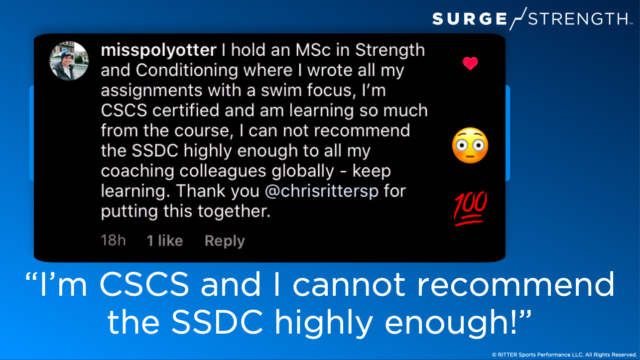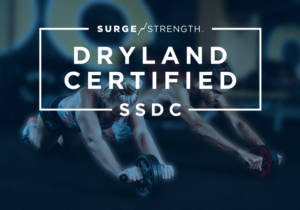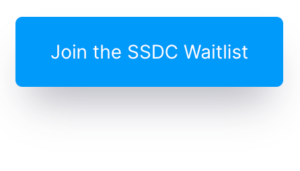While SURGE Strength continues to deliver the best team Dryland Program experience, we’re now giving coaches the same tools we use to maximize program results when they enroll to Become SURGE Strength Dryland Certified (SSDC).
The next Open Enrollment to Become SSDC is coming soon, so mark your calendars for October 2nd, 2023. It’s only a few weeks away and it’ll be for a limited time.
At the end of the day, most swim coaches want to learn how to make more effective Dryland plans. Likewise, they want to learn how to coach the programs they have better.
Inside of the SURGE Strength Dryland Certification Curriculum, we fully unpack everything coaches need to know about creating and executing a year-round Dryland plan. Here, we give you a taste of what we teach inside the course. Below are the top 5 answers to YOUR most frequently asked Dryland questions around coaching and programming. Learn 5 of the best ways to get your Dryland program up to par with the best in the business:
Team Dryland Program Question #1: Where do I Start?
Answer: Start with the Basics
It seems counter-intuitive, but the best dryland programs are the ones that keep it simple. Tired of repeating yourself when you tell your swimmer to fix their stroke in the water? Chances are, they need to learn better basic movement patterns on land first in order to be able to make the changes you’re asking them to do. The best way to teach your swimmers better body mechanics is by implementing fundamental movement patterns into your dryland program. These include pushing, pulling, squatting, hinging, and bracing the core. For a full breakdown on these movements, check out our previous article on The 5 Basic Movement Patterns. Once swimmers attain more athleticism through dryland, you will notice a difference in the water right away because mobility, strength, endurance, and stroke technique improve. Furthermore, the prevalence of injuries decreases.
As a coach, basic programming makes your job easier, too. By teaching the basics, everyone gets on the same page. Athletes who have a younger training age catch up quicker. Additionally, athletes who are more experienced gain better movement quality. As a result, your workouts are more effective and easier to coach. With better body awareness, your athletes will be easier to coach in the water as well. Instead of trying to keep up with the latest trends in the fitness industry, stick with the tried-and-true training principles that get results.
Team Dryland Program Question #2 – How do I implement this exercise I found on YouTube?
Answer: Your Practice Needs Structure, So Does Your Dryland
In order to get results from dryland, your plan needs structure. The most successful swim programs have a template to work off when it comes to their training plan in the pool. Therefore, it makes sense that dryland plans should have a template as well. Coaches should know what phase of dryland training they are in throughout the season. For instance, dryland workouts should not be random workouts from the internet or be made up on the spot. Instead, they should be planned ahead of time with simple and effective periodization programming in mind.
The best way to create an appropriate dryland plan is to consider who you are training and work backwards from your end of season goals. For instance, dryland for a 10 & under group is going to look very different than high school dryland. In order to know which dryland training plan is appropriate for your team’s age group (including master’s and triathletes) check out the list of resources below:
Team Dryland Program Question #3 – Only Some of My Swimmers are into Dryland… How do I Motivate the Others?
Answer: Identify Which Coaching Style Works Individually
You can have access to the best equipment and programming, but swimmers will not benefit from dryland unless they are executing it well. Therefore, your ability as a coach is imperative. The best way to improve your coaching strategies and increase buy in from your athletes is by getting to know them. Identifying your athletes by how they respond to your coaching style will help indicate how to approach them on days where they are less than their best. To learn how to communicate better with different personalities on your team, check out our article on The 4 Coaching Styles.
Team Dryland Program Question #4 – Should I Focus on Challenging the Swimmer Who is Most Athletic in Dryland, or Including the Athlete Who is Least Athletic in Dryland?
Answer: Scale Workouts for Your Individual Swimmers
Chances are, you have various ability levels within your team. In order to make dryland work for everyone, each session needs to be adaptable. We focus on scaling dryland programs often because the ability to progress and regress each session is what keeps coaches in the driver’s seat of getting results. Scaling dryland allows you to work from 1 individualized dryland program even when training many athletes. As situations arise throughout the season, you can regress or progress each session without compromising the overall dryland plan. Likewise, you don’t have to worry about changing the set-up, equipment, or flow of the workout when swimmer’s need to deviate from the original workout. To learn more about how to scale a dryland plan, check out our most popular articles, Leveling Up Dryland.
Team Dryland Program Question #5 – How Do I Teach Basics to Younger Athletes?
Answer: Keep it (Mostly) Fun & Games
Dryland games are an essential part of dryland plans for all ages. For youth athletes, they are the foundation of dryland. For older athletes, they are a tool for building cohesion within a team. When games are implemented appropriately, they train coordination, rhythm, body awareness, reaction, strength, balance, power, and overall athleticism. They also keep swimmers engaged and prevent them from burnout: especially as yardage in the pool becomes tedious mid-season. In addition, games develop basic abilities in your athletes that they will use in everyday life such as leadership, coach-ability, and social skills. Check out our article on Dryland Games for Swimmers for ideas you can use in practice today. We guarantee that when you put games into dryland, swimmers will get more out of each session and look forward to doing dryland again.
As coaches, we all want the best for our swimmers. The best way we can ensure that they are getting the best experience possible is by becoming better ourselves. By using the resources throughout this article, you can elevate your coaching skills and strategies and create a Dryland plan with purpose. Learn how to scale it to the athletes on your team. Make Dryland fun, and most importantly, get to know your athletes. There are many ways to go about Dryland programming. Just remember to keep it simple.
JOIN OTHERS FROM AROUND THE WORLD THAT ARE
BECOMING SURGE STRENGTH DRYLAND CERTIFIED (SSDC)

LEARN ABOUT BECOMING SSDC
MORE DRYLAND RESOURCES FROM SURGE STRENGTH:
ENROLL IN A DRYLAND 101 COURSE FOR FREE
GET STARTED WITH A DRYLAND PROGRAM

SURGE Strength’s Mission:
BUILD BETTER ATHLETES
GENERATE FASTER SWIMMERS
Courtesy of SwimSwam’s exclusive dryland training partner, SURGE Strength.
SURGE Strength is swim-specific, strength training by Chris Ritter. SURGE Strength builds better athletes and faster swimmers through Dryland Programs, Courses and Certification.










